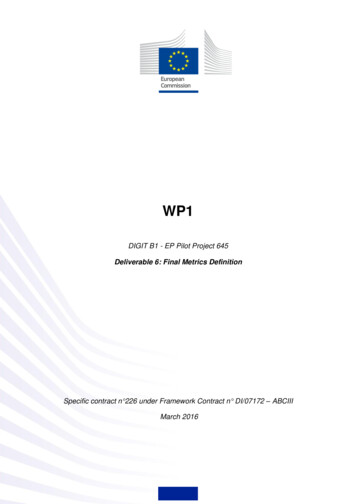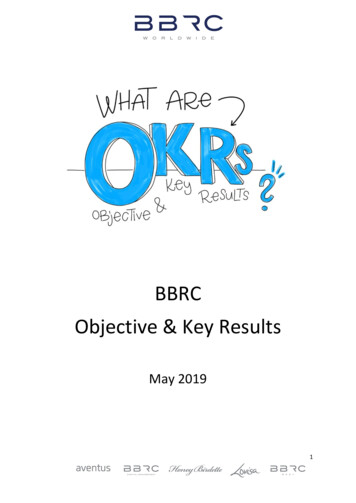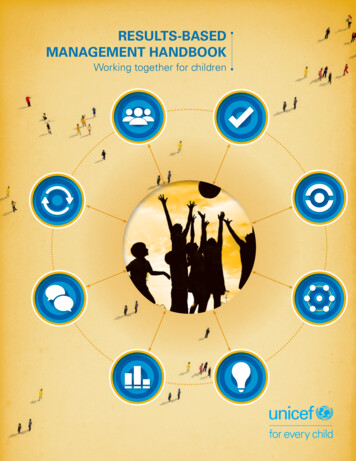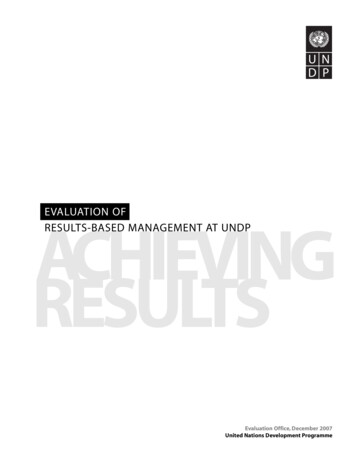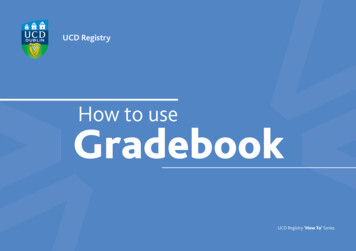
Transcription
FEN MEETINGBERLIN, 16 May 2018PROJECTPRESENTATIONAnna SACIO-SZYMAŃSKAInstitute for SustainableTechnologies – NationalResearch – Institute (ITeE-PIB)The European Commission support for the production of this publication does not constituteendorsement of the contents which reflects the views only of the authors, and the Commissioncannot be held responsible for any use which may be made of the information contained therein.
Project rationale and objectivesMOTIVATIONEvident need to better navigate in an eraof rapid change, technological disruptions,turbulence and volatile markets.FORESIGHTAnticipating the futureFUTURES LITERACY (FL)Practical knowledge of using the futureENTREPRENEURSHIPShaping the futureENTREPRENEUR ASTUTEPerson having the ability to accurately assesssituations, people, facts and events and turnthis to one’s advantage (Online Oxford Dictionary)Increase Future Literacyamong students,entrepreneurs andacademicsIntegrate Foresight withother academicdisciplinesGuide individuals andorganisations inadvancing their futurepreparedness2
Project core outcomesFORESIGHT CAPACITY BUILDINGis instrumental to nurture future– oriented individualsHow to educate future-orientedentrepreneurs? let’s start from buildingforesight capacities atentrepreneurship andmanagement faculties . let’s blend traditional methodsfor strategic management, withmethods that enhance ourcapabilities for thinking andexploring the future ONLINE COURSEIN FUTURES LITERACY16h 6hAcademic:teaching practiceresearch practiceStudent:career pathprofessional development16h 8h16h 4hEntrepreneur:business developmentprofessional development3
Project partnershipPROJECT PARTNERS4 countriesPoland, Italy, Germany, Spain10 institutionsASSOCIATED UniversitiesItalySpain associated networks4
Ongoing workIdentificationCompetences ValidationNeeds analysisDevelopmentEducational offerCreating the set ofcompetences of futureoriented Individuals Evaluating the competencesby the target groups Developing the on-linetraining courses5
Best practice: an integrated approachHow to select really key competences?A mix of human experts, stakeholders involvement, and computer algorithmsSelection of relevant foresight courses,academic literature, syllabuses,business foresight practices193 sourcesExtraction of ”candidates” by variousmethodological approaches1 000 records of competencesCleaning, clustering and structuring,via human analysis and NLP software12 clusters and 50 sub-clustersInterviews and statistic analysis,competence-stakeholder correlationlist of 56 core competences,matched with O*NET DatabaseOnline survey among target groupsRanking of 12 competences6
12 competences for online survey7
General ranking based on survey resultsThe research sample consisted of 346respondents; rather evenly representing: Working population (academics: 21%,business representatives: 24%) andStudyingcommunity(universitystudents: 55%).8
Target group preferences9
Future-orientationof our research sample (individual)How familiarare you withthe conceptsof foresight/futuresliteracy?Based on http://devmts.org.uk/dreyfus.pdf and lsknowledge.pdf10
Future orientationof our research sample (organisational)What is thelevel of theproficiency ofyour companyin the field ofForesight?Based on Grim 2009 ght-maturity-model/)11
Implications of the survey resultsfor beFORE e-learning programme developmentIn a view emerging from the results of the survey, that is: The relatively low level of ‘Foresight awareness’ and Similar competence choices across the different target groups,it seems reasonable to the project consortium to offer a basic course andaccompanying, advanced thematic courses, which could be of interest toany of the target groups’ representatives. Both basic, and advanced coursescould fall into the four module framework:Module 1Module 2Module 3Module 4An overview of thefield and bringingin the perspectiveof personal futuresRationale behindforesight, areas ofits application,outcomes, impactsand risksMethods / Toolsneeded to workwith the abstractideas of futures /uncertaintyCommunicating theresults to variousaudiences andstimulating agency12
Dissemination reportsThe course will be piloting in2019. Please visit our website:futureoriented.eu to find outmore about the course and our#beFORE project.13
FEN MEETINGBERLIN, 16 May 2018THANK YOUAnna SACIO-SZYMAŃSKAInstitute for SustainableTechnologies – NationalResearch – Institute (ITeE-PIB)Anna.Sacio@itee.radom.plOffice mob. 0048 663 234 455The European Commission support for the production of this publication does not constituteendorsement of the contents which reflects the views only of the authors, and the Commissioncannot be held responsible for any use which may be made of the information contained therein.
Selection of relevant foresight courses, academic literature, syllabuses, business foresight practices 1 000 records of competences Cleaning, clustering and structuring, via human analysis and NLP software Interviews and statistic analysis, competence-stakeholder correlation list of 56 core competences, matched with O*NET Database 193 sources


